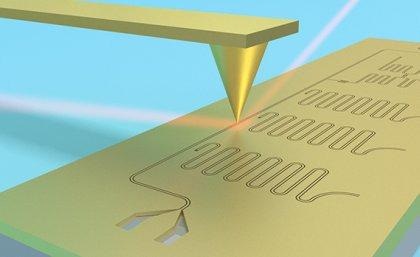Reviewed by Alex SmithSep 2 2021
A new approach discovered by engineers and physicists helps determine and deal with imperfections present in materials for one of the most promising technologies in commercial quantum computing.
 Schematic of a superconducting circuit [thin black lines] on a silicon chip [yellow base], being imaged using terahertz scanning near-field microscopy [red beam focused into yellow tip]. Image Credit: The University of Queensland.
Schematic of a superconducting circuit [thin black lines] on a silicon chip [yellow base], being imaged using terahertz scanning near-field microscopy [red beam focused into yellow tip]. Image Credit: The University of Queensland.
Researchers from the University of Queensland developed treatments and improved fabrication protocols in general methods for constructing superconducting circuits on silicon chips.
According to Dr. Peter Jacobson, who co-led the study, the research team had found that imperfections caused during fabrication were responsible for the decrease in the effectiveness of the circuits.
Superconducting quantum circuits are attracting interest from industry giants such as Google and IBM, but widespread application is hindered by ‘decoherence’, a phenomenon which causes information to be lost.
Dr. Peter Jacobson, Study Co-Lead Researcher, The University of Queensland
“Decoherence is primarily due to interactions between the superconducting circuit and the silicon chip — a physics problem — and to material imperfections introduced during fabrication — an engineering problem. So we needed input from physicists and engineers to find a solution,” added Jacobson.
The researchers utilized a technique known as terahertz scanning near-field optical microscopy (THz SNOM) — an atomic force microscope integrated with a THz light source and detector. This offered a combination of high spatial resolution — observing down to the size of viruses — and local spectroscopic measurements.
According to Professor Aleksandar Rakić, this method allowed nanoscale probing instead of macroscale probing by focusing light onto a metallic tip.
This provides new access for us to understand where imperfections are located so we can reduce decoherence and help reduce losses in superconducting quantum devices. We found that commonly used fabrication recipes unintentionally introduce imperfections into the silicon chips. which contribute to decoherence. And we also showed that surface treatments reduce these imperfections, which in turn reduces losses in the superconducting quantum circuits.
Aleksandar Rakić, Professor, The University of Queensland
According to Associate Professor Arkady Fedorov, this enabled the researchers to identify where the defects in the process were initiated and to improve fabrication protocols to handle them.
Our method allows the same device to be probed multiple times, in contrast to other methods that often require the devices to be cut up before being probed. The team’s results provide a path towards improving superconducting devices for use in quantum computing applications.
Arkady Fedorov, Associate Professor, The University of Queensland
THz SNOM could be used in the future to specify new approaches to enhance the operation of quantum devices and their integration into a feasible quantum computer.
Journal Reference:
Guo, X., et al. (2021) Near-field terahertz nanoscopy of coplanar microwave resonators. Applied Physics Letters. doi.org/10.1063/5.0061078.